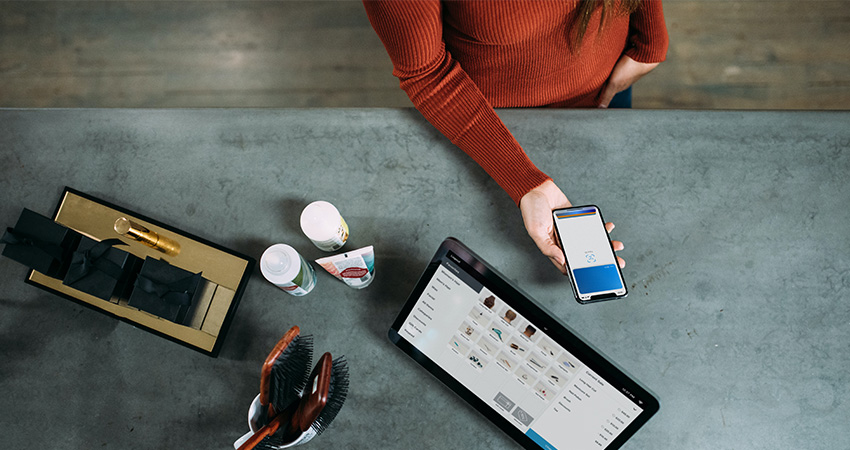Mobile commerce is a comer with many benefits, and open banking growth is a driver (credit: Blake Wisz on Unsplash)
Nearly every consumer has a smartphone with them as they shop, carrying mobile commerce potential in their pocket or purse. They’re so ubiquitous, in fact, that checkout-less stores taking payments from mobile wallets are now a possibility. Most stores, however, are still card- and cash-centric, and are likely to be for a long time.
While payment cards are one of the safest, fastest and most friction-less forms of payment yet devised, mobile wallets built into smartphones are faster and safer still. Studies have found most consumers feel they can leave their wallet home and just use their phone, with the figure higher for younger consumers. There is much more that could be done if mobile devices became more prominent in retail.
We have already seen how checkout-less stores bridge the gap between mobile and brick-and-mortar retail, but the transformation doesn’t have to be so radical, and the technology isn’t suitable for every retailer. While it works for grocery stores, “just walk out” doesn’t necessarily work for furniture. A much wider range of retailers can incorporate in-store pickup, digital receipts or ordering via QR codes. In the furniture store example, customers can scan a QR code for purchase, and choose to have it delivered to their home at a convenient time. Associates are then freed up to help customers with more complex needs, instead of simply processing orders.
Furthermore, open banking technology has created the possibility for direct account-to-account transfers from customer to retailer. This is more resistant to fraud and, crucially for retailers, less expensive per transaction. Brick-and-mortar retailers need to find a way to integrate this technology into their store shopping experiences.
Merging Mobile and Brick-and-Mortar Retail
In the last five years, we have seen brick-and-mortar retailers adapting to a hybrid digital-physical model. Even before the pandemic, ecommerce had been fundamentally altering how companies work and ultimately who could stay in business. Covid then became a catalyst that increased the rate of change. In a socially-distanced world, retailers invested in systems enabling curbside or store pickup and moved more of their operations online.
We are a long way from resolving contradictions between digital and physical retail. There will still be companies like Bed, Bath and Beyond, that close their doors in part because of a failure to adapt to a changing marketplace. The lesson of the many companies that have shut down in the past decade isn’t that ecommerce has “won” against brick-and-mortar retail, but that that companies need to find ways to adopt, with mobile commerce at the forefront.
Meeting Shopper Needs
Whatever you’re selling, there’s a very good chance your customers can find it cheaper online, and in greater varieties. Next-day or even same-day shipping is often the norm, often with free delivery (although that’s changing), so the argument for in-store retail for many items seems to be quite weak. Retailers need to give people a reason to invest their time in a store trip, and mobile commerce can help. This can include enabling store cards or digitizing payments to let them shop how they want.
Providing Options
Not everyone will want the traditional retail experience of going to a physical store and checkout. Again, mobile commerce is a great enabler here. Customers have a way to interact with the store digitally if they wish.
Concentrating on the Bottom Line
Every penny counts when retail margins are being squeezed more than ever, and mobile commerce can be a major asset to your business. It unlocks the potential for digital customer interactions without investing in touchscreen kiosks and other expensive technologies; every customer brings their own touchscreen with them. It also enables open banking payments with significantly cheaper transaction costs than debit and credit transactions. Once they’re set up, they are extremely easy to use; this is especially true of recurring payments.
The global open banking market was valued at $20.07 billion in 2022, according to Grandview Research, and is expected to grow at a compound annual growth rate (CAGR) of 27.2% from 2023 to 2030. This can be accelerated if brick-and-mortar retail, mobile commerce and open banking were to come together. It would enable much easier and safer payments, but that depends on getting people to the point that they want to use it as much as their cards.
Mobile is key here: devices that nearly everyone owns enable shoppers to easily set up open banking payments. The technology is here, so retailers need to find ways to integrate it in a way that’s mutually beneficial to them and their customers.
Jeremy Nicholds is CEO of Judopay

